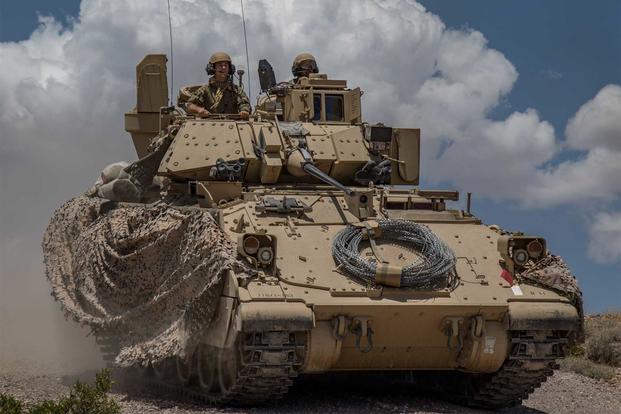The Army is down to just one bidder -- General Dynamics Land Systems -- to engineer and design a Bradley Infantry Fighting Vehicle replacement. But the fast-track program is still on course, service officials said Monday.
The demanding "threshold requirements" for the Next Generation Combat Vehicle (NGCV) program, including development of a robotic Optionally Manned Fighting Vehicle (OMFV), will remain in place, said Brig. Gen. Ross Coffman, head of the Army's Cross Functional Team for the NGCV.
"I am very confident in my threshold requirements" to bring a replacement for the venerable tracked Bradleys online, possibly by 2026, despite the limited competition, Coffman said at the Association of the U.S. Army's annual exposition and convention in Washington, D.C.
One of the requirements is that a C-17 Globemaster cargo aircraft be capable of carrying two of the NGCVs.
Related: Check out Military.com's AUSA Convention Coverage
Coffman said he is barred from commenting on the bidding process, first reported by Defense News, that left General Dynamics as the sole competitor.
"We're not at liberty, and frankly I'm firewalled off from the specificity of what's going on with that," he said.
BAE Systems previously dropped out of the competition, while the Army's Future Command ruled that a demonstrator from Raytheon and Germany's Rheinmetall was submitted too late.
"Competition is a component, but that's only one component," said Col. John Bryan, project manager for next-generation combat systems.
The Bradley replacement program aims to acquire 3,800 vehicles in total.
"We're trying to mature and develop and evaluate," he said. "We'll award our contracts, we'll evaluate them, and if we're meeting what the Army wants to do, we'll go forward. And if we need to re-evaluate, we will."
Coffman noted other difficulties ahead for the program.
"The Army's track record on modernization of ground vehicles is not awesome. We have a huge -- a monumental -- task in front of us, and that's to modernize the track vehicle fleet and get that into the hands of our soldiers," he said.
However, "if just the threshold requirements are met by anyone, we're going to have the best vehicle on Earth," he added.
The "optional" part of the Optionally Manned Fighting Vehicle also presents huge problems in terms of the ability of artificial intelligence to operate the vehicles robotically, said Jeffrey Langhout, the civilian director of Combat Capabilities Development Command, Ground Vehicles Systems Center, in Warren, Michigan.
In developing the robotics and autonomous systems for a combat vehicle, "we're relying a lot on the car industry" for their expertise and the "sensors that they're using to keep you from running into stuff," Langhout said.
He cited the problem of a robotic vehicle approaching what may be a puddle that can be ignored, or a body of water that can swallow the vehicle. The technology that can make that distinction hasn’t been figured out yet, he said.
And it's not just puddles, he added.
"We're the Army," and Army vehicles are expected to go where there aren't roads, "so we have a long way to go in autonomous activities," Langhout said.
Then there's the problem of getting robotic vehicles and manned vehicles to exchange information, he said.
"The greatest challenge we face if you want to go completely autonomous" is in the "ability to communicate effectively between the robotic vehicles and the control vehicles -- electromagnetics is just a pain," Langhout said.
The communication problems multiply in difficult terrain and especially "in the middle of cities," he said.
"Radio waves are just the way that they are," he said, "and I think we're talking about potentially a lot of data" that the Army would like to be shared between the autonomous and manned vehicles. "And I think ultimately that's going to be our single largest challenge."
-- Richard Sisk can be reached at Richard.Sisk@Military.com.
Read more: The Army Is Evaluating a Knee Brace that Aims to Make Climbing Effortless













